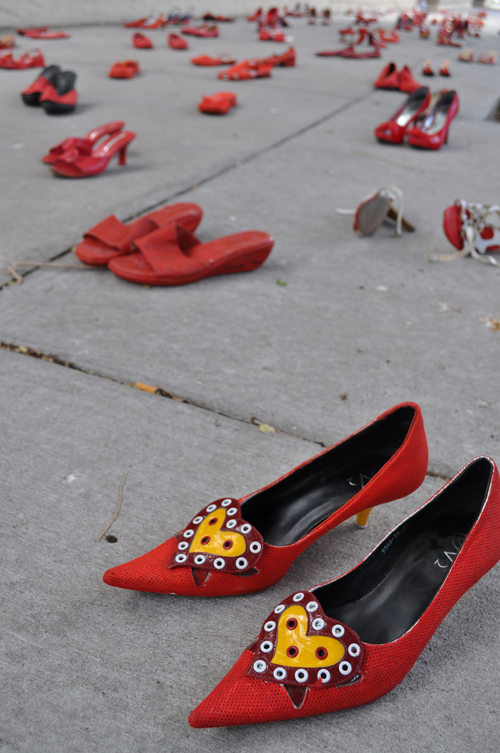It was in 2009, while teaching art workshops in Ciudad Juárez, that artist Elina Chauvet became aware of the numbers of women and girls disappearing from the city’s streets. She was shocked by the many posters on phone poles and boards pleading for help locating missing women. Most were never to be seen again—probably victims of rape and murder. The authorities were putting practically no effort into tracking down the guilty parties. Those lives were not considered of value by those in power. Chauvet conceived of a project to draw global attention to this tragedy.
Zapatos Rojos (Red Shoes) was always intended, Chauvet explained, to be “a huge event, a social event.” We spoke in a friend’s sun-filled casa in Mazatlan’s historic district. Dark-haired Elina, attractive, mature yet youthful, has flashing eyes and a ready laugh. But her cheerful disposition veils a dead-serious commitment. Well aware that “so many activists on this subject were frequently intimidated, or killed,” the artist felt that engaging many people would not only spread her message more widely, but “would also serve as protection.” Chauvet embarked on a grassroots campaign for justice, putting out the request through friends for donations of red shoes.
Each pair of shoes symbolizes a woman who vanished from the streets of Ciudad, red representing their spilled blood. Her first installation comprised 33 pairs of shoes, installed back on the very Juárez sidewalks where the women had been abducted; slingbacks, pumps, boots and even children’s Mary Janes, suggesting shoes the women and girls might, in fact, have worn, lined up as though in a procession bearing witness to the crimes.
Chauvet, no stranger to personal tragedy, lost her sister 22 years ago—murdered by a husband never prosecuted for the crime. While Elina had known “from the day I was born that I was an artist,” her studies were in the field of architecture, right in Ciudad Juárez. It was after the death of her sister that she returned to her fine art work, finding in it a way to work through her pain. Her early works were influenced by Picasso, Magritte and Kahlo. Expressionistic and personal imagery combining women in shawls, hearts, birds, flowers and angels filled her vibrant canvases. These garnered some recognition, in the U.S. as well as Mexico, but it was her fierce commitment to her installation work that has attracted international attention.
The Zapatos Rojos project has taken on a life of its own. Already taken to six locations in Mexico, Chauvet installed the Zapatos Rojos last July in front of the Mexican consulate in El Paso, Texas. This drew the attention of women worldwide—and the international human rights community. The project was selected in Italy to represent the International Day for the Elimination of Violence Against Women, and her work has, in conjunction, been installed in Milan, Turin, Genoa and Lecce; the artist will travel to Bergamo, Italy in May for its installation events there.
While so many have embraced Zapatos Rojos, including families of the missing women—mothers of the victims installed the piece in Ciudad Juárez last December—the government of Chihuahua State continues to turn a blind eye. It is the unwillingness, if not complicity, of the government that has allowed this appalling situation to exist. Chauvet remains optimistic, “the minds of women in Mexico are changing. They are not accepting the violence anymore, and are talking about it. Before they did not talk about this. Maybe this is the first step.”



